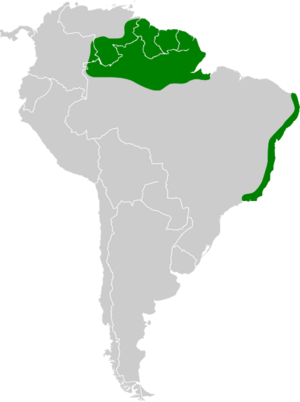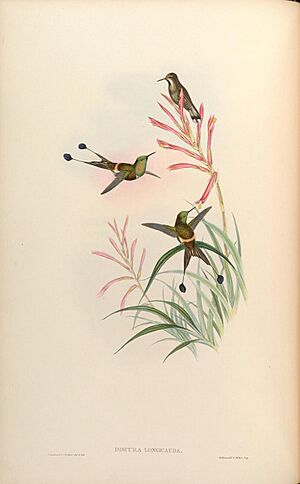Racket-tailed coquette facts for kids
Quick facts for kids Racket-tailed coquette |
|
|---|---|
 |
|
| A male in Pernambuco, Brazil, spreading its tail | |
| Conservation status | |
| Scientific classification | |
| Genus: |
Discosura
|
| Species: |
longicaudus
|
 |
|
| Range of the racket-tailed coquette | |
| Synonyms | |
|
Discosura longicauda (Gmelin, 1788) |
|
The racket-tailed coquette (Discosura longicaudus) is a tiny, colorful hummingbird. It lives in the northeastern parts of South America. This bird is known for its unique tail feathers that look like little rackets!
Contents
About the Racket-tailed Coquette
The racket-tailed coquette got its name because of its special tail. The word Discosura comes from Ancient Greek words meaning "plate" and "tail." This refers to the round, paddle-shaped feathers at the end of its tail. The word longicaudus comes from Latin words meaning "long" and "tail," which also describes its long tail.
What Does It Look Like?
This hummingbird is quite small. It weighs about 3.4 grams (which is less than a nickel!). The male and female birds look different from each other. This is called sexual dimorphism.
The male racket-tailed coquette is about 10.2 centimeters (4 inches) long. It has a bright green head and throat. Its belly is a shiny copper color. The male's tail is dark purple-brown and about 5.1 centimeters (2 inches) long. It is forked, meaning it splits into two long parts. Each part ends with a round, paddle-shaped feather, like a tiny racket!
The female bird is shorter, about 6.9 centimeters (2.7 inches) long. Her upper body and chest are a duller green. She has a black throat with white edges and a white belly. The female's tail is grey with white tips and does not have the "racket" feathers.
Where Does It Live?
The racket-tailed coquette is not very common, but it lives in a large area. Its home is split into two main parts. The biggest part is in the Guiana Shield region. This includes northern Brazil, French Guiana, Guyana, Suriname, and southern Venezuela.
The other part of its home is a strip along the eastern coast of Brazil. These birds like to live in tropical rainforests. They also enjoy forests that grow near rivers, called riparian forests.
How Does It Behave?
Racket-tailed coquettes often gather high up in the treetops. They sometimes join other hummingbirds to feed. They are known to try and steal nectar from larger hummingbirds. Because of this, bigger birds often chase them away!
Nests and Reproduction
Female racket-tailed coquettes build small, cup-shaped nests. They use soft plants and fluffy down to make them. These nests are usually built about 3 to 6 meters (10 to 20 feet) high in a tree.
Females typically lay two eggs at a time. They sit on the eggs to keep them warm for about 13 to 14 days. This process is called avian incubation.



